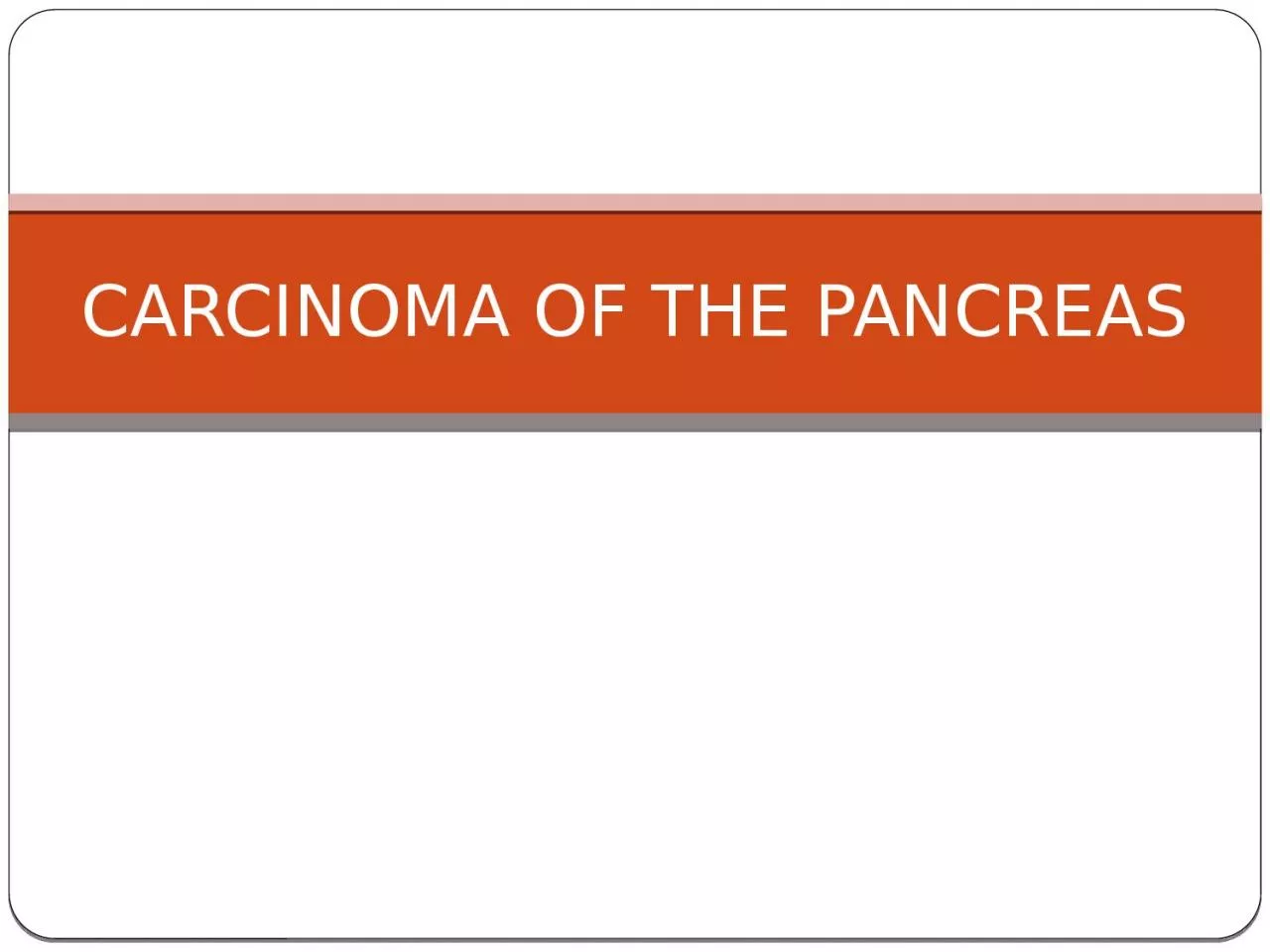

Pancreatic cancer is the sixth leading cause of cancer death There is no simple screening test More than 85 per cent of pancreatic cancers are ductal adenocarcinomas The remaining tumors constitute a variety of pathologies with individual characteristics Endocrine tumors of the pancreas are r ID: 1041584
Download Presentation The PPT/PDF document "CARCINOMA OF THE PANCREAS" is the property of its rightful owner. Permission is granted to download and print the materials on this web site for personal, non-commercial use only, and to display it on your personal computer provided you do not modify the materials and that you retain all copyright notices contained in the materials. By downloading content from our website, you accept the terms of this agreement.
1. CARCINOMA OF THE PANCREAS
2. Pancreatic cancer is the sixth leading cause of cancer death.There is no simple screening test.More than 85 per cent of pancreatic cancers are ductal adenocarcinomas.The remaining tumors constitute a variety of pathologies with individual characteristics. Endocrine tumors of the pancreas are rare.Ductal adenocarcinomas arise most commonly in the head of the gland. They are solid, scirrhous tumors, characterized by neoplastic tubular glands within a markedly desmoplastic fibrous stroma
3. pathologyCystic tumors of the pancreas may be serous or mucinous. Serous cyst adenomas are typically found in older women, and are large aggregations of multiple small cysts, almost like bubble wrap. They are benign. Mucinous tumours, on the other hand, have the potential for malignant transformation. They include mucinous cystic neoplasms (MCNs) and intraductal papillary mucinous neoplasms (IPMNs)Mucinous tumors can be confused with pseudocysts
4. Peri-umpullary tumorsGroup of tumors of different origin around ampulla of Vater.it includes:1-doudenal tumor . 2-lower CBD cholangiocarcinoma. 3-pancreatic head tumor 4-others other malignant neoplasms can arise at the ampulla, such as carcinoid tumors 5- high-grade neuroendocrine carcinomas.It constitute around a third of all tumors in that area. Their natural history is distinctly more favorable compared with pancreatic ductal adenocarcinoma? Why??????
5. Clinical featuresDepends on the site of the tumorHead : painless jaundice with nausea , epigastric discomfort , Pruritus, dark urine and pale stools with steatorrhoea.Upper abdominal symptoms in a recently diagnosed diabetic, especially in one above 50 years of age, with no family history or obesity, should raise suspicion.
6.
7.
8. Body and tail vague discomfort, anorexia and weight loss, and are frequently dismissed by both patient and doctor.Back pain is a worrying symptom, raising the possibility of retroperitoneal infiltration.Occasionally, a patient will present with an unexplained attack of pancreatitis. It is often grow silently, and present at an advanced unresectable stage.
9. ExaminationCourvoisier law: when the common duct is obstructed by a stone, distension of the gall bladder (which is likely to be chronically inflamed) is rare; when the duct is obstructed in some other way, such as a neoplasm, distension of the normal gall bladder is common.Other signs of intra-abdominal malignancy should be looked for with care, such as a palpable mass, ascites, supraclavicular nodes and tumour deposits in the pelvis; when present, they indicate a grim prognosis.
10.
11. InvestigationCBP blood film morphology.LFT ---- obstructive jaundice. Ultrasound will determine whether or not the bile duct is dilated. If it is, and there is a genuine suspicion of a tumor in the head of the pancreas, the preferred test is a contrast-enhanced CT scanIn the majority of instances, this should establish if there is a tumour in the pancreas and if it is resectable. The presence of hepatic or peritoneal metastases, lymph node metastases distant from the pancreatic head, encasement of the superior mesenteric, hepatic or coeliac artery by tumour are clear contraindications to surgical resection.? WHAT findings are not contraindication to resection of pancreatic mass.
12. ERCP and biliary stenting is indicated in:1- if there is any suggestion of cholangitis.2- if there is diagnostic doubt (small ampullary lesions may not be seen on CT.3- if the patient is deeply jaundiced (serum bilirubin >250 mmol/L), or there are distressing symptoms (e.g. pruritus) and there is likely to be a delay between diagnosis and surgery. It relieves the jaundice and can also provide a brush cytology or biopsy specimen to confirm the diagnosis.Why? It is not mandatory in every case.
13. EUS:1-if CT fails to demonstrate a tumour. 2-if tissue diagnosis is required prior to surgery (e.g. a mass has developed on a background of chronic pancreatitis and a distinction needs to be made between inflammation and neoplasia).3- if vascular invasion needs to be confirmed.4- in separating cystic tumors from pseudocysts.Transduodenal or transgastric FNA or Trucut biopsy performed under EUS guidance avoids spillage of tumour cells into the peritoneal cavity. Percutaneous transperitoneal biopsy of potentially resectable pancreatic tumours should be avoided as far as possible. Histological confirmation of malignancy is desirable but not essential, particularly if the imaging clearly demonstrates a resectable tumor
14. Managementmore than 85 per cent of patients with ductal adenocarcinoma are unsuitable for resection because the disease is too advanced.If a cystic tumors is encountered, no matter how large, surgical resection should be considered, as it carries a reasonable chance of cure. Tumors of the ampulla have a good prognosis and should, if at all possible, be resected
15. SURGERY FOR CARCINOMA HEAD PANCREASSurgical resection The standard resection for a tumor of the pancreatic head or the ampulla is a pylorus-preserving Pancreatoduodenectomy (PPPD). Or Whipple procedure.
16.
17. BODY AND TAILDistal pancreatectomy with splenectomy
18. Palliation in unresectable tumor
19.
20. Preoperative preparation to patient with obstructive jaundice:Intravenous fluid preferably G\W + mannitol 200ml\twice daily in order to prevent hepatorenal shut down.Vitamin K….why?Antibiotics….types and why?Laxative ( PEG )……why?Non absorbable antibiotics……..why?Management of pruritus…….why?